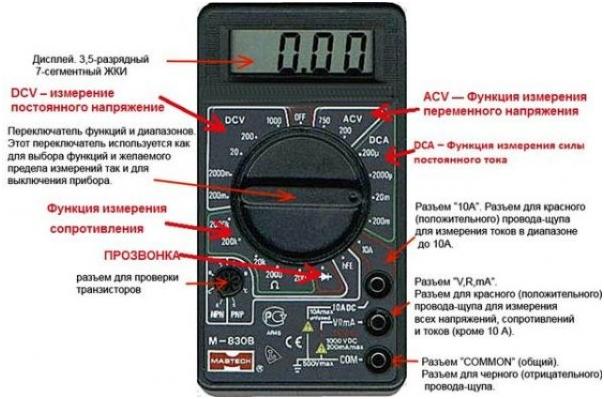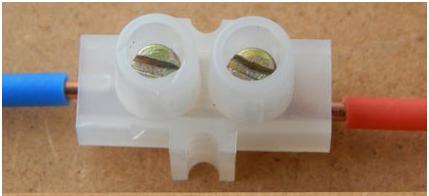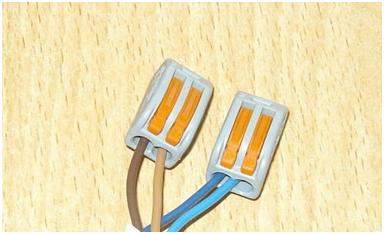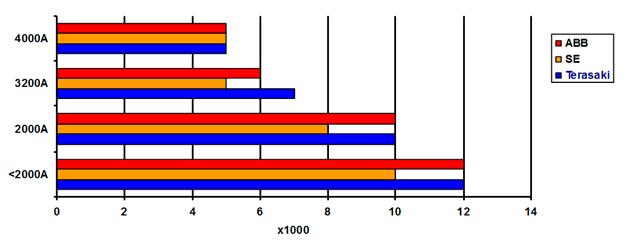Electricity is a source of energy, and is useful until it gets out of hand. Having escaped to freedom, it can create many troubles, the main of which is a fire.
The main cause of fire hazards is, of course, faulty electrical wiring. It is necessary to monitor the condition of the insulation of wires and cables, in time to replace the damaged ones. Also, the old wiring, made "under Tsar Pea", is a great danger in the fire plan. Over time, the insulation of such wires simply dries out, cracks and crumbles, which can lead to a short circuit and fire in the premises.
The old wiring was carried out with wires, the insulation quality of which was much lower than that of modern ones. It is worth remembering at least the cords of old electrical appliances in filament insulation or external open wiring on ceramic rollers.
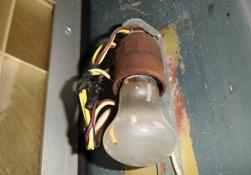 The reason for the increased fire hazard may be the insufficient cross section of the conductive conductors (TPZh). A wire with a cross section of TPZH 0.75mm2 is quite sufficient to connect a light bulb or even a chandelier. But if you connect a modern washing machine, iron or kettle, then it will get very hot, which will lead to melting of the insulation, and then to a short circuit. Strictly speaking, the cross section of the TPG is selected from the expected load either according to calculations or using ready-made tables at the design stage of the electrical wiring.
The reason for the increased fire hazard may be the insufficient cross section of the conductive conductors (TPZh). A wire with a cross section of TPZH 0.75mm2 is quite sufficient to connect a light bulb or even a chandelier. But if you connect a modern washing machine, iron or kettle, then it will get very hot, which will lead to melting of the insulation, and then to a short circuit. Strictly speaking, the cross section of the TPG is selected from the expected load either according to calculations or using ready-made tables at the design stage of the electrical wiring.
Electricity leak
Damage to the wire insulation may cause a malfunction such as leakage. This is the probability that, under certain conditions, some of the energy may go in the wrong direction. A simple example. The wires are laid under the plaster.
In the dry state, it is an excellent insulator, so damage to the insulation of the TPG is not detected in any way. But if, under some conditions, the plaster gets wet, for example, heating or plumbing leaks, it immediately becomes conductive, not even a source of electricity. If a person comes into contact with such a wall, an electric shock is quite possible.
Short circuit and his reasons
It is known that faulty electrical wiring leads to a short circuit, which most often causes a fire. This is often mentioned in fire reports. What is a short circuit, why is it dangerous?
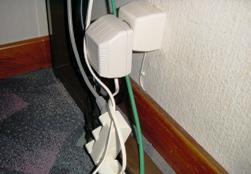 In normal operation, the current in the wiring between the phase and neutral wires flows through the load, which limits this current to a level that is safe for wiring. When the insulation is destroyed, the current flows, bypassing the load, immediately between the wires. Such a contact is called short, since it occurs in addition to the electrical appliance.
In normal operation, the current in the wiring between the phase and neutral wires flows through the load, which limits this current to a level that is safe for wiring. When the insulation is destroyed, the current flows, bypassing the load, immediately between the wires. Such a contact is called short, since it occurs in addition to the electrical appliance.
Short circuit— electrical connection two points of the electrical circuit with different meanings potential that is not provided for by the design of the device and disrupts its normal operation. A short circuit can occur when the insulation of current-carrying elements is broken or due to mechanical contact of elements operating without insulation. Also, a short circuit is a condition when the load resistance is less than internal resistance power source.
Types of short circuits
In three-phase electrical networks There are the following types of short circuits:
- Single-phase (phase-to-earth short circuit);
- Two-phase (shorting two phases together);
- Two-phase to ground (2 phases between each other and simultaneously to ground);
- Three-phase (3 phases among themselves).
AT electrical machines possible short circuits:
- Interturn - short circuit between the turns of the windings of the rotor or stator;
- Closing the winding to a metal case.
Protection methods
To protect against short circuits, special measures are taken:
- Limiting short circuit current:
- Relay protection devices are used to disconnect damaged sections of the circuit
Causes of short circuits
The main cause of short circuits is violations of the insulation of electrical equipment.
Insulation faults are caused by:
1.Surge(especially in networks with isolated neutrals),
2. Direct lightning strikes
3. aging insulation,
4. Mechanical damage to the insulation, passage under the lines of oversized mechanisms,
5. Poor maintenance of equipment.
Often the cause of damage in the electrical part of electrical installations are unskilled actions of service personnel.
Intentional short circuits
When implementing simplified connection diagrams for step-down substations, special devices are used - short circuiters that create deliberate short circuits in order to quickly disconnect the damage that has occurred. Thus, along with random short circuits in power supply systems, there are also intentional short circuits caused by the action of short circuits.
Consequences of short circuits
When short circuits occur in the power supply system, its total resistance decreases, which leads to an increase in currents in its branches compared to normal mode currents, and this causes a decrease in the voltage of individual points of the power supply system, which is especially large near the short circuit.
Depending on the location and duration of the damage, its consequences may be local or affect the entire power supply system.
If the short circuit is far away, the value of the short circuit current can be only a small part of the rated current of the supply generators, and the occurrence of such a short circuit is perceived by them as a slight increase in load. A strong voltage drop is obtained only near the short circuit, while at other points in the power supply system this reduction is less noticeable. Consequently, under the conditions under consideration, the dangerous consequences of a short circuit appear only in the parts of the power supply system closest to the accident site.
The short circuit current, even though small compared to the rated current of the generators, is usually many times higher than the rated current of the branch where the short circuit has occurred. Therefore, even with a short-term short-circuit current, it can cause additional heating of current-carrying elements and conductors above the permissible level.
Short-circuit currents cause large mechanical forces between the conductors, which are especially large at the beginning of the short-circuit process, when the current reaches its maximum value. With insufficient strength of the conductors and their fastenings, mechanical failures can occur.
A sudden deep voltage drop during a short circuit affects the operation of consumers. First of all, this applies to motors, since even with a short-term voltage drop of 30-40%, they can stop (the motors tip over). Overturning engines seriously affects the operation of an industrial enterprise, since in order to restore normal production process a long time is required and an unexpected stop of the engines can cause the rejection of the company's products.
With a small distance and a sufficient duration of a short circuit, it is possible for parallel operating stations to fall out of synchronism, i.e. violation normal operation the entire electrical system, which is the most dangerous consequence of a short circuit.
The unbalanced current systems arising from ground faults are capable of creating magnetic fluxes sufficient to induce significant EMF in neighboring circuits (communication lines, pipelines), dangerous for the operating personnel and equipment of these circuits.
Thus, the consequences of short circuits are as follows:
1. Mechanical and thermal damage to electrical equipment.
2. Fires in electrical installations.
3. Reducing the voltage level in the network, leading to a decrease in the torque of the electric motors, their braking, reduced performance, or even to overturn them.
4. Loss of synchronization of individual generators, power plants and parts of the electrical system and the occurrence of accidents, including system failures.
5. Electromagnetic influence on communication lines, communications, etc.
Causes of electrical wiring failure
Most common causes short circuit of electrical wiring and breakage of wires is the aging of insulation and conductors of wires. This is especially true for aluminum wires.
Insulation cracks and falls off over time. Without insulation, wires create increased danger for a person, especially on damp walls, since damp walls are a good conductor for current. Another cause of wiring failure is wiring overload caused by improper the right choice wire size, or the selection of the circuit breaker does not match rated current wires.
During an overload, the wires overheat, the insulation dries and crumbles, the contacts of switches, sockets, and lighting lamps burn out. All wiring faults caused by overloading the network can also cause a short circuit in the wiring, which often leads to a fire.
Incorrect wiring can also cause a short circuit in the wiring. If the wire connection is broken, the resistance of the contacts increases, which causes heating of the connections and burning of the wires. As a result, a short circuit of the wiring and insulation fire is possible. Therefore, special care must be taken when connecting wires.
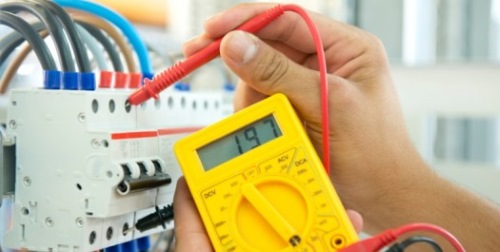
Connections in electrical wiring by soldering, crimping, welding are allowed. Another cause of electrical wiring failure is the human factor. By not careful actions, a person can fill the electrical wiring with water, damage the wires during repair work (drill, chop off, close).
Finding faulty electrical wiring
To determine the location of a wiring fault, you need a 220 V low power test lamp and a multimeter. When troubleshooting, they check the phase on the outlet; if there is a malfunction in the lighting, they look for the phase on the terminal block in front of the lamp. The phase is checked with an indicator.
If there is a phase, but there is no 220 V, then the fault is in the neutral wire. Before ringing the neutral wire, you need to turn off the introductory machine in the electrical panel. Next, open the distribution box, find the neutral wire and call it with the neutral wire of the outlet. If zero does not ring, then you need to look for a place where zero breaks from the box to the outlet. To find the place of the break, it is convenient to use the detection detector. concealed wiring.
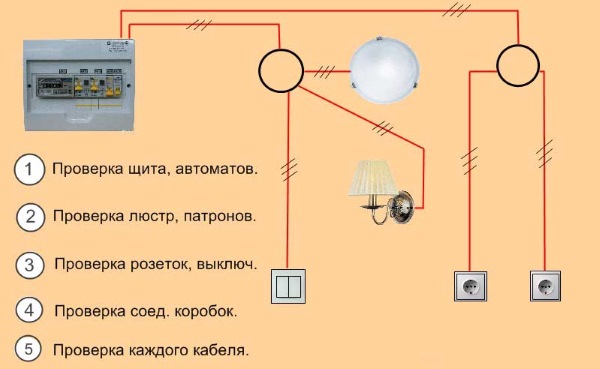
The sequence of actions when troubleshooting electrical wiring
In this case, the phase wire of the socket in the distribution box is disconnected (turning off the input), and the neutral wire is connected in its place. They turn on the introductory machine and look for the place of damage with a detector. If the wiring is hidden, then the plaster is opened at the place of the break and an insert is made with a wire.
The insertion point is conveniently insulated with heat shrink tubing. Diameter heat shrink tubing taken 2 times larger than the diameter of the wire. We are looking for a break in the phase wire in the lighting or in the outlet in a similar way. If there is no 220 V in all rooms, then the troubleshooting starts from the electrical panel and further through the junction boxes.
Short circuit wiring
Before searching, you must turn off all household appliances from outlets and all lighting. It is more convenient to search for the cause of the electrical wiring short circuit together. Having turned off the introductory machine, the multimeter probes are placed on the de-energized terminals of the introductory machine, to zero and phase. If there is no short circuit, then the assistant turns on the lighting in turn until zeros appear on the multimeter display, or it beeps.
In the event of a short circuit in the wiring when the lighting and household appliances are turned off, disconnect the common wires of the phase and zero in the junction boxes, starting from the far room, until the wiring is closed. In the room found with a short circuit, all sockets, lighting are checked, and possible damage to the wires after recent mechanical work is examined.
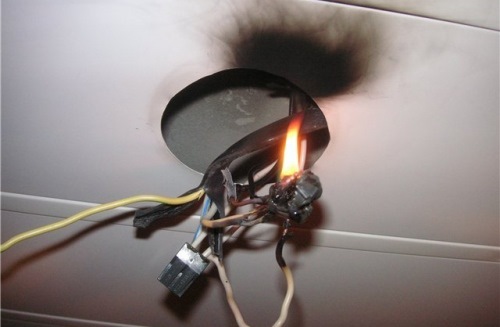
You can determine the place of a short circuit by a specific smell, visual inspection. If a short circuit has occurred in the socket, the terminal block of the lamp or on the cases of other electrical products, do not try to clean the carbon deposits, it is better to replace the entire product.
Soot is a trace of coal, soot, which has little resistance, and if you leave such a product, then a short circuit can occur again in the area of \u200b\u200bcleaned soot. In order to prevent the occurrence of a short circuit in the electrical wiring, you must follow all the installation rules, select the cross section of the cable cores and install circuit breakers corresponding to the rated current of the electrical wiring.

The presence of electricity in the house ensures the comfort of its inhabitants and successful activities in various fields. In the event of a malfunction in the electrical wiring networks, the usual rhythm of life is disturbed. In order to quickly eliminate this problem, you need to have certain knowledge and practical skills. In the article we will consider wiring malfunctions in a house, apartment and methods for finding and fixing the problem.
Basic rules for installing electrical wiring in apartments and private houses
In order to quickly identify faults in electrical wiring networks and navigate in places where it is laid, recommended to read typical schemes and installation requirements.
The starting point from where the power supply comes from and is distributed into groups in private houses and apartments is the introductory switchboards (ASU). The main elements of the ASU:
- Introductory circuit breaker to the metering station (electric meter);
- electric meter;
- Device protective shutdown(RCD);
- Protective circuit breakers for various groups of consumers, lighting, sockets, heating appliances, and other household appliances;
- Plank (tire) for fastening zero wires "N";
- Tire (bar) for fastening ground wires "PE".
Wires are routed from the machines of each group through junction boxes to sockets, switches, and lighting fixtures. Household appliances that consume high power electricity are connected by a separate wire, through an individual machine.
Photo No. 1 an example of connecting group machines to the ASU
To make it easier to navigate during the repair process, circuit breakers in the ASU are marked with inscriptions:
- lighting;
- sockets;
- boiler for heating water;
- air conditioner;
- electric stove (in the kitchen) and other possible consumers of electricity.
It is not always necessary to deal with ideal conditions when the groups in the ASU are signed. In such cases, it is necessary to be guided by the fact that circuit breakers are installed taking into account the maximum possible power of electrical appliances in a given section of the circuit. Practice shows that in apartments and private houses on various groups, automatic machines with tripping currents are installed:
- lighting group from 10 A to 16A;
- sockets 16 - 25 A;
- washing machine 25 A;
- electric stove 25A.
The thickness of the wire in groups in different parts of the circuit may differ:
- Socket chains on the main line between junction boxes are laid with wires with a cross section of 4 sq. / mm. From the boxes to the outlet, a thinner wire is laid, with a cross section of 2.5 sq. / mm.
- In lighting circuits, wires with a cross section of 2.5 sq. / mm are laid between junction boxes. From the box to the switch and the lighting device, wires 1 - 0.75 sq. / mm are used.
- Separate wires from the ASU are laid on air conditioners and electric stoves, bypassing junction boxes, with a cross section of at least 6 sq. / mm.

Table number 1. Characteristics of cables often used for wiring PUNP and PUGNP
According to the requirements of the PUE (Rules for the operation of electrical installations), the installation of power supply to residential facilities is carried out according to a three-wire scheme. Cables with three copper wires double insulated with different colors:
- blue or black wire is used as neutral zero "N";
- red or brown connects to phase;
- yellow - green is connected to ground.
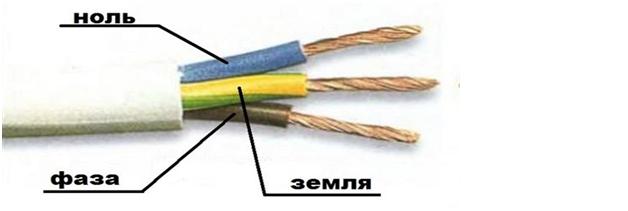
Photo No. 2 Three-wire cable with wire marking by color
All these requirements form certain signs that indirectly facilitate the troubleshooting of electrical wiring and ensure the safety of workers.
Features and differences of electrical wiring in apartment and private houses
In modern apartment buildings the power supply scheme is carried out according to standard designs, with wiring hidden under plaster. Switchboards with metering devices are located at the entrances on the landing. In some cases, in the entrance there is only a common machine and a meter for the apartment, group circuit breakers are placed in a separate switchgear (switchgear) in the apartment.
In private houses, in addition to traditional lighting groups and sockets, outbuildings can be allocated to a separate wiring group:
- workshop;
- sauna;
- street lighting:
- garage power supply;
- a barn with rabbits and other options.
Depending on the building material, in wooden structures, open wiring installation methods in plastic cable ducts can be used. Connections between buildings are carried out by underground cable or air lines. Each building can be equipped with its own switchgear with group automatic switches.
The most common electrical wiring faults in private and multi-apartment buildings
The causes of malfunctions in electrical wiring are various, the most common:
- A short circuit of the neutral or ground wire to the phase wire can occur due to lack of insulation, aging of the insulating layer or its burning as a result of excess current loads, unreliable contact at the joints. If the circuit breaker does not work, such a malfunction may lead to a fire;
- Lack of phase or neutral wire contact in junction box, on the terminals of switches, circuit breakers, sockets or lamp sockets. This happens from heating the contact connectors, poor-quality cleaning of the contacts, insufficient tightening of the wire fastening bolts on the contact group.
- Breakage of wires, most often found at the points of connection to switches, cartridges, sockets. When replacing lamps, the wires at the cartridge are bent, in junction boxes and sockets during installation, the wire bends and breaks inside the insulation. This may not appear for some time, but then the weak contact will burn.
- Violation of the integrity of the wires of hidden wiring can occur as a result of drilling walls;
- There are times when circuit breakers in the switchgear break down, they can break the circuit or close. When switching, the electrical contacts do not close or open, sometimes the cocking mechanism jams, and it is impossible to switch it.
The main measuring and indicator devices necessary for repair
It doesn't take many expensive tools to find and fix faults in your home's wiring. Enough indicator screwdriver and a tester or multimeter.
Indicator screwdriver
Indicator screwdriver can be of three types:
- With a neon indicator lamp, the current from the phase wire goes to the tip, through the resistance to the lamp, then to the contact of the handle where the person touches. The body works like a capacitor in this circuit. The currents are very small to kill a person, but enough to light a light bulb. With such an indicator, you can determine the phase with a voltage of 60V.
- Indicators with an LED indicator are self-powered by batteries, the principle of operation is similar to a neon screwdriver. In this case, the schema includes bipolar transistor which enhances sensitivity to electric field. It is possible to determine not only the phase with a voltage of up to 60 V, but also to identify break points in cables and hidden wiring.
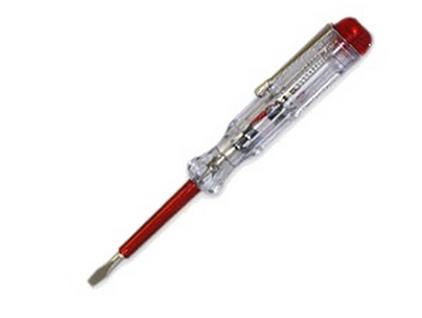
Photo #3. Indicator screwdriver with LED lamp
- Indicator screwdrivers with a liquid crystal display have an LED, acoustic indicator and show the voltage in volts.
Multimeters
These devices are universal, they can measure current, voltage, resistance and be used as an indicator for continuity of wires, detect a short circuit in the circuit.
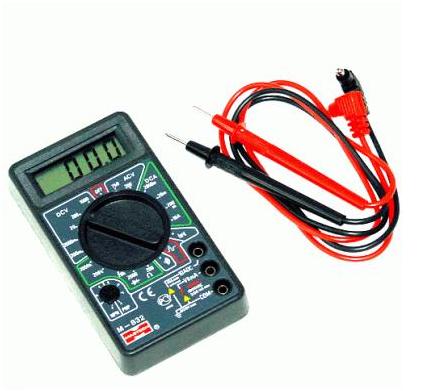
It is convenient to use models with digital indication, modern devices are available with current-measuring clamps, which allows you to measure load currents in the circuit using a non-contact method.
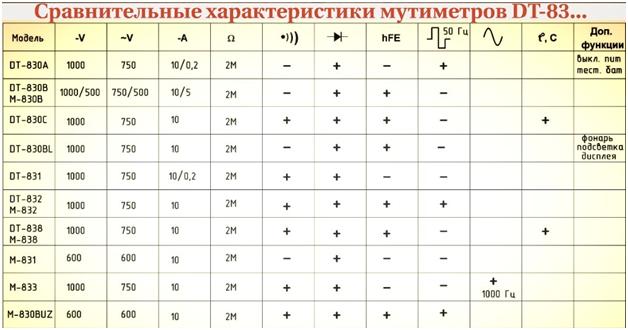
Table No. 2 Comparative characteristics of multimeters of the DT-83 series
Troubleshooting Technique and Solutions
In the absence of voltage in the entire apartment or house, first of all open those ASUs, check that the power supply is supplied from the industrial network. At the same time, on modern appliances the LED indicator flashes, the old counters do not have such an indicator. In such cases, the presence of voltage is checked indicator screwdriver or multimeter. If there is no voltage, call the power supply company and make a request for troubleshooting.
If there is voltage at the output of the input machine and the meter, check the RCD, when it is triggered, the switch will be visible in the off position, turn it on.
When there is no voltage in a separate group, lighting or socket, also start the test from the position of the circuit breakers in the switchgear. If the machine constantly trips without a connected load in the circuit, there may be two reasons:
Fault number 1. Short circuit in circuit, turn off the circuit breaker, disconnect the phase wire at the output and ring the circuit with a multimeter phase - zero and phase - earth. To do this, you need to make sure that all load elements in the network of this group were turned off, to exclude the passage of the indicator signal through their circuits, the device is set to the continuity mode. In the lighting network, turn off all switches, it is better to unscrew the bulbs, because the short circuit may be in a faulty switch.
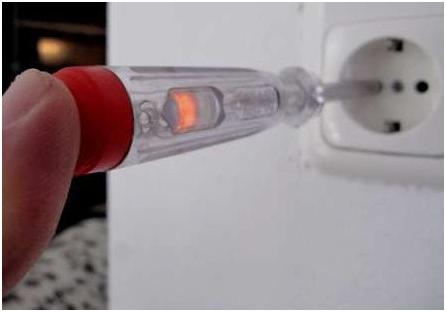
Photo #5. An example of checking the presence of voltage on a phase wire with an indicator screwdriver
One clamp from the multimeter is applied to the wire disconnected from the machine, the second to the blue wires fastening bus N and then to the ground bus with yellow-green wires PE.
Practical Tip #1 - for reliability, you can disconnect the cable wires of the tested group from the busbars and conduct a short circuit test directly between them. If there is a short circuit between the wires, the multimeter will give a sound indication, zeros will appear on the LCD screen.
It must be understood that in the continuity mode, the device works as an indicator, this is not a measurement of circuit resistance. Using a multimeter to test a short circuit is effective in an apartment, in short sections up to a maximum of 8-10m with a good battery charge of the device. To check a short circuit in private houses, on long wires, between structures, poles street lighting it is recommended to use professional megohmmeters, type M-416.
When a short circuit is detected, it is necessary to identify the place or section of the circuit where it occurred. In order not to do unnecessary work, the elements of this group, lamp sockets, sockets, switches, junction boxes are visually inspected. Having found obvious signs, digging, melting of the plastic case, smells of burnt insulation, we remove these elements, disconnect wires from them. Sections of wires with molten insulation are cut off, the ends of the wires are separated in different directions to prevent a short circuit. Re-testing for a short circuit is done, in its absence, install a new cartridge or socket, you should not repair burnt elements.
Photo No. 6. Panel with controls for selecting the operating mode of the multimeter
If no suspicious elements are detected or a short circuit is not eliminated after their removal, the section of the circuit on which it occurred is determined. In the socket group from the socket to the junction box, in the lighting network from the box to the switch with the cartridge. Open the cover of the junction box, disconnect the phase wire of the outlet or switch being tested from the common twist of the phase wire connection. Check the multisite for contact between the phase - neutral and phase - ground wires, if any, the wire in this section of the circuit will have to be replaced.
A short circuit may occur in the area between the junction boxes and the ASU. In these cases, the technique is similar, the phase wire of the tested group is disconnected from the machine and in the first junction box. The presence of contact between phase zero and phase ground in this section is checked. Further, the phase of this group is turned off at the first and second junction boxes from the ASU, in the area between them, the presence of phase contact with zero and ground is checked. Sequentially ringing the circuit, the section in which the short circuit is sure to be determined.
Fault number 2. Faulty circuit breaker in the ASU
It happens that when one light bulb is turned on, the circuit breaker knocks out; if the wiring is in good condition, there is no short circuit, it is clear that the circuit breaker is faulty. Possible excess admissible current load circuit of this group, to make sure of this, take current measurements. You can connect a pointer ammeter to the break of the phase wire and the circuit breaker, but it is more convenient to do this with a multimeter with current clamps. Measurements are carried out by a non-contact method, the required current measurement limit is set on the device. The pliers wrap around the space around the phase wire at the output of the machine, the digital screen shows the current strength in the circuit.
If the current is exceeded, turn off unnecessary devices, faulty Appliances may consume more energy. Specify the maximum current consumption of these devices according to the documents, take measurements, if the consumption is much more than declared, hand over the equipment for repair.
There are malfunctions in the circuit breaker; when switching, the contacts do not close or open. This is easily determined with a conventional indicator screwdriver. The presence of phase voltage at the input is checked, in the on position, the phase must be at the output. If it is not there, the device is faulty, when the phase is present at the output in the off position, this is also a sign of a malfunction, change the switch.
Open circuit
The absence of voltage at the ends of the wires for the socket or lamp socket indicates an open circuit. First of all, check the reliability of the contacts at the junctions. Next, use the multimeter in dial mode. It is necessary to disconnect the phase wire from the circuit breaker in the tested group, connect it to the neutral wire. The multimeter terminals are connected to zero and the phase of the outlet, if both wires are intact, an acoustic signal will sound, zeros will appear on the display. If there are no signals, in order to determine the zero is broken or the phase, close each separately in a pair with a ground wire and ring. If the break is in a pair of phase - the ground is interrupted, if the pair is zero - the ground is cut off. A break can be on three wires at once, in the ideal case it is necessary to change the entire section of the three-wire cable.
The damaged area is determined by successive disconnection of the phase and neutral wires of the tested group, between the boxes, between the socket and the box, the switch and the box. At one end they are closed, at the other they are connected to a multimeter, ringing. So you can ring any intermediate interval in the circuit of the faulty group.
There are more simple methods detection of a break in a hidden wiring that does not require disconnection and continuity of wires in the cable. In the event of a phase failure, you can use an indicator screwdriver that is sensitive to the electric field powered, battery operated. Putting your finger on the contact on the screwdriver handle, draw the tip along the surface of the wall under which the phase wire is laid. The indicator LED will light up, in the place of phase failure it will go out.
To determine the breakage of hidden wiring, special devices "Woodpecker" E-121 are used; MS - 158 M; BOSHDMF - 10 zoom. But these devices are used by professionals, certain knowledge is needed and they are expensive. In domestic conditions, it is easier to find a multimeter, a sensitive indicator screwdriver with measurement limits of 50mV-500V.
It is necessary to determine the break points and call individual broken wires in order to make connections. It is not always possible to replace a hidden section of wiring; this may be associated with costly repairs. Sometimes, in order not to crumble the plaster between the box and the socket, the wire that was used for zero is connected to the place of the broken phase, and the zero on the socket is connected to the ground wire. Connections according to this scheme work, there are different variants connections in order not to crumble the walls, but they can be used in extreme cases, when there are no other options.
Methods for connecting wires in areas of faulty wiring
There are many proven ways to securely connect and extend wires:
- The easiest twisting of bare ends;
- Usage connecting blocks with screw terminals;
Photo number 7. sockets with screw terminals
- An effective way to connect when building up wires is the use of WAGO pads, they provide reliable current transfer even between wires of different metals.
Photo #8. Block WAGO
- There are special cylindrical sleeves for connecting the wiring, into which the stripped ends of the wires are inserted. Then the sleeve is crimped with a special key or pliers. Before connecting, a heat-shrinkable insulating tube is put on one of the wires, it is pulled over the sleeve and subjected to heat treatment. Then hermetically compresses the junction of the contacts.
Safety rules for repairing electrical wiring in apartments and private houses.
The main task for safety during repair work with electrical wiring is not to touch bare live wires with open areas of the body. Especially when voltage measurements are made with a multimeter, the presence of a phase is checked with an indicator screwdriver.
Before carrying out work on disconnecting or connecting switches, sockets, lighting cartridges, stripping wires, dialing with a multimeter, make sure that the measuring and indicating devices are in good condition. Test the multimeter and indicator screwdriver on a properly functioning electrical circuit.
Turn off the machine on the ASU of the group where the work is being carried out, block the machine or put up a warning sign "do not turn on people working." Council number 2, for reliability, you can disconnect the wire at the output of the protective switch, close the doors of the ASU cabinet, keep the key with you. Before starting work on site, check the absence of voltage with an indicator screwdriver or multimeter. After making sure that the desired machine is turned off, there is no voltage, you can proceed with the installation work.
Frequently asked Questions
Question number 1. You can connect or build up wires from different metals?
According to the requirements of the PUE, all wiring in residential premises is not recommended copper wire. Contacts with different metals heat up, unnecessary losses, increased power consumption, the risk of a short circuit and fire. In extreme cases, at low load currents, pads are used WAGO connections, they provide high conductivity and low heating of the contact group.
Question number 2. Is it possible to use a two-wire cable in the area from the junction box to the luminaire, and a three-wire cable to the chandelier without a ground wire?
If the housings of the chandelier and lamp are plastic or made of dielectric material, you can. Products with a metal case are recommended to be grounded.
Question number 3. Which model of circuit breakers is better to use in the ASU for separate groups?
Reliable modular circuit breakers of the ABB series, they have a wide range of current limits.
Table No. 3 electrical service life of circuit breakers of different manufacturers
The vertical axis shows the maximum current loads during operation, the horizontal axis indicates the number of operations x per 1000 times.
Question number 4. Can you fix the circuit breaker yourself?
Replace defective switches with new ones. Self-repair of such a switch and further operation can lead to an emergency.
Question number 5. Can a ground wire be used instead of a neutral wire?
In certain sections of the circuit where the neutral wire is damaged, you can put a jumper from zero to ground. It is not recommended to disconnect the ground wire from the terminal of the socket or lighting device.
The presence of circuit breakers on individual wiring lines allows you to quickly find a short circuit on a blown fuse. If the apartment does not provide for selective protection, additional time will be required to examine the junction boxes and connections. Before starting work, turn off both circuit breakers feeding the apartment.
Opening junction boxes
The wiring diagram in the apartment may be different, however, all cables converge in one or more junction boxes. They are located at a level of 10-30 centimeters from the ceiling and are often visible from the protruding covers. If the boxes were walled up, you can find them by tapping on the surface with the handle of a screwdriver. Where the sound of impact becomes muffled, there is most likely a cavity in the wall in which the box is mounted.First of all, you need to find the connection of the lines that feed the sockets. Usually these are two twists with the largest number of wires of a thicker section. Single connections are typical for the phase wire of the lighting line and the return wire of the switch. The socket lines must be disconnected and the ends apart. The cable feeding the box usually departs from it in the direction of the front door. The paired ends of the wires must be checked for a short circuit, after disconnecting household appliances from the sockets. In the same way, you should check the lines of lighting and switches by opening the circuit in advance and unscrewing the lamps from the cartridges.
If the circuit was not found, you need to establish an exact correspondence between the wires in the box and the consumers to which they are connected. To do this, the tester probes are connected to the contacts of the socket or lighting cartridge and alternately close the wires in the box until a signal about the presence of a circuit appears. In the event of a short circuit, the cable core may burn out completely, so it will not respond to a short circuit. Also, the problem may be hidden in the wire that feeds the box.
Elimination of a short circuit
When a problem line is detected, you must first open the socket or lighting cartridge and visually inspect the contact joints for soot, melting or wire breakage. If the problem persists, you will need to check the cable from the side of the outlet for contact between the two cores. Very often there is damage to the wire immured in the wall. In this case, a new cable will be required.To supply voltage to serviceable lines, disconnect the short-circuited section in the junction box. After that, the twists or terminal connections are assembled and checked for a short circuit without connecting consumers to the network. If the line is working, you can apply voltage to the apartment.
You absolutely do not want to test the effect of electricity on yourself when you start to drive a nail into a wall or drill a hole for more serious fasteners. To avoid this contact, you need to know exactly where the hidden electrical wiring lies. It is better for complete amateurs to look for electrical networks with the help of special devices.
You will need
- - hidden wire detection detector.
Instruction
The layout of home wiring, taken from the housing and communal services, can seriously let you down if the electricians did not lay the wires as recommended by the standards. With the help of devices, you can find a break or a damaged section of electrical wiring.
When choosing a device called a locator, tester, finder, detector or hidden wiring probe, pay attention to the convenience, sensitivity and safety of the device. There are those that need to be connected to the network, which is not always convenient if it is faulty. Other appliances are testing and looking for electro wiring contactless way. Just take the device and pass it over the desired area, it will somehow indicate the presence of voltage.
The Bars metal detector is a Russian non-contact device, it allows you to detect both cables and fittings in a reinforced concrete structure, which is also useful for repairs. It is easy to work with this device - slide the front of the device along the surface, touching it. If the indicator LED changes color to red, you have found what you are looking for.
The 6888-138 non-contact detector may be useful to you, it looks for live electrical networks when electrical appliances are turned on. It will also detect fasteners and metal structures hidden at a depth of 2-3 cm. The MS-58M tester-probe also works, and with its help you can detect harmful electromagnetic radiation. The MS-158M indicator will find the phase wire and hidden wiring.
"Ivan-n" is a voltage signaling device and will not react to metal, but it will perfectly detect hidden electrical networks under voltage of 220/380 V. Five indicator lights are visible on its front panel. As the voltage rises, more bulbs light up. There is also a sound accompaniment of the operation of the device - rare signals become more frequent when the device finds wiring.
With the help of the Dyatel hidden wiring alarm, you will find the phase wire and check the correct connection of household electricity meters, find out the fuse is working, and find the location of the power outage.
If you need to find wiring, lying at a depth of up to 30 cm, you will need a specialized device POSP-1. This device looks like a hand-held radar equipped with a rotating antenna, it reports the find with sound and light signals.
The foreign model VP-440 will detect breaks in cables and wires, determine the route of a hidden electrical network, identify blown fuses and much more. The new Sonel hidden electrical communications search kit - LKZ-700 has proven itself well. He is able to find illegal contours of meters, cable runs at a depth of two meters, damage to the power grid underground, individual cores in the wire system.
Sources:
- Equipment for searching hidden wiring in 2017
- how to detect wiring in the wall in 2017
Has a music lover settled behind the wall, or does the sound of a hammer not stop on the floor above? What can be done if the neighbors do not stop doing repairs in their apartment even late at night? It is necessary to achieve silence with the help of the law.

What is prohibited
The Code of Administrative Offenses, as well as their own silence laws adopted in Russian cities, do not allow noise in the evening and at night. In Moscow, silence must be observed from 23:00 to 07:00. On weekends and holidays, it is now possible to sing loudly, tap dance, use a drill or a perforator (it was forbidden before). True, there is not much time for this - from 9:00 to 19:00.
Even during the daytime, it is forbidden by law to produce noise above 40 decibels. This noise level corresponds to the sound of, for example, closing elevator doors.
All ways are good
It happens that tenants who rent an apartment make noise. In this case, calling the police will help. A squad will arrive, call the owner of the apartment. To begin with, they will have a conversation with him and write out a fine.
The noise behind the wall is constant - contact the district police officer to draw up a protocol. If a neighbor, having paid a fine, continues to bother with his behavior, sue. The act of measuring the noise level can be proof of your innocence. The commission must arrive with a special measuring device at the very moment when the neighbor breaks the silence.
Court cases
Restless neighbors are sometimes evicted from their apartments, and housing is sold at auction. The funds received as a result of the transaction are given to the former owner square meters. He buys another home and makes noise at a new address. Please note that even if you team up with your neighbors, you cannot file a lawsuit to evict the owner of the apartment. Only the local administration has the right to do this.
The troublemaker occupies the area under a social tenancy agreement - it is easier to evict him, a lawsuit can be filed by disgruntled tenants.
If the neighbors flooded
Forgetful neighbors are also a serious problem. If streams ran along the ceiling and walls, you need to act like this:
1. Turn off the power to the apartment, the wiring can be closed from water.
2. Take care not to flood the lower floor.
3. Go up to your neighbor and find out what caused the disaster. It happens that it is not an open tap that is to blame, but a burst pipe. If the problem is due to a malfunction, call the emergency service.
4. Having eliminated the cause of the flood, immediately call the representatives of the Housing Office to draw up an act on the damage. If the experts try to reduce the damage in the document, order an independent examination.
5. If the flood was caused by a leaky roof or a rotten pipe, contact the housing inspectorate.
6. A negligent neighbor is to blame for the leak and it is impossible to agree with him on voluntary compensation for damage - go to court.
Related videos
As a rule, the need to connect an electrical doorbell occurs when the entrance doors are installed or changed, or the bell wire is damaged. Also, when moving to new apartment. The easiest way to solve this problem is to call an electrician from the Housing Office, but you can try to connect an electric call on one's own.
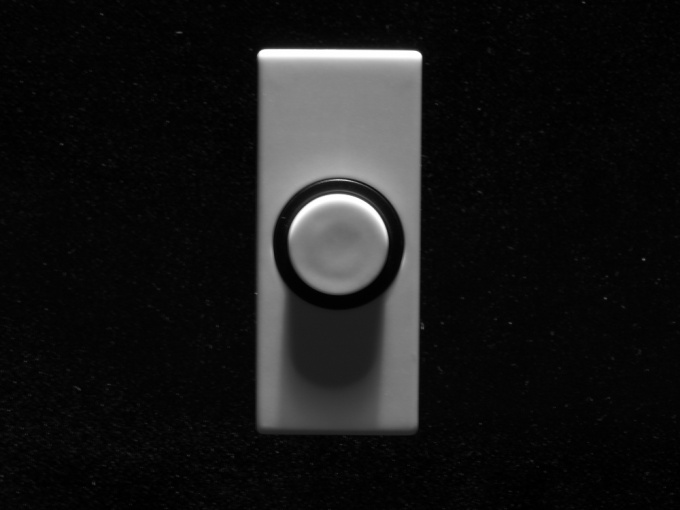
Instruction
In the event of a malfunction of the electric bell, first of all check how tight the wires are to the terminals of the bell and the transformer. Then remove the cover from the bell button and check the elasticity and contact of the spring when it is pressed.
One of the reasons that the bell does not work may be an open circuit, if the tip of the contact screw does not fit snugly enough on the armature. This is due to too much voltage in the circuit, burning of the contact screw, or loosening of the fixing locknut. In this case, it is necessary to clean the contact between the spring and the screw with fine sandpaper.
